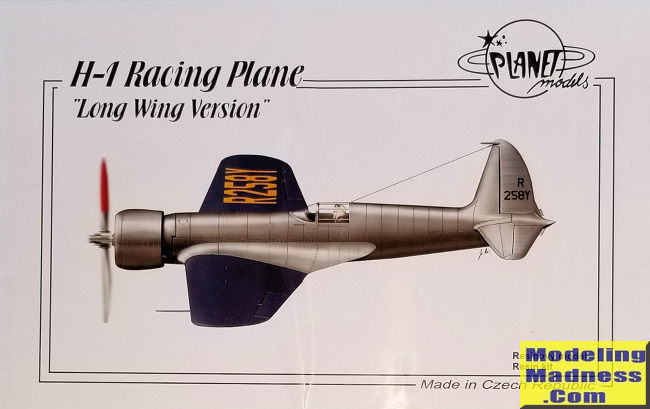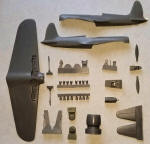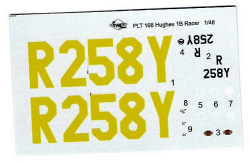
| KIT #: | 168 |
| PRICE: | $48.00 on sale |
| DECALS: | One options |
| REVIEWER: | John Summerford |
| NOTES: | Resin with vacuformed canopies |

| HISTORY |
“The Hughes H-1 racer was developed to be the fastest landplane in the world, it was designed by Howard Hughes and Richard Palmer and built by Glenn Odekirk. On September 13, 1935, Hughes achieved the design goal by flying the H-i to a new world speed record of 352.322 mph. The record was set over a specially instrumented course near Santa Ana, California.
Since Hughes did not require a sponsor for the aircraft, the H-1 had no markings except the license number NR258Y (later NX 258Y) in chrome yellow against the dark blue background of the wings, and in black against the doped aluminum rudder. The fuselage was left in its natural polished aluminum finish. The H-i was powered by a Pratt and Whitney Twin Wasp Junior radial piston engine, which was rated at 700 horsepower at 8,500 feet but which could deliver 1,000 horsepower for high-speed flight. A wind tunnel model of the aircraft was exhaustively tested in the 200-mph wind tunnel at the California Institute of Technology’s Guggenheim Aeronautical Laboratory. Actual performance figures for the aircraft closely matched the predicted design performance.
The H-1 had two sets of wings, The wings Hughes used to break the land plane speed record were of a low aspect ratio and shorter than those with which it is now fitted. The wings now fitted on the aircraft span 31 feet, 9 inches. have a moderate-aspect ratio, and were used when Howard Hughes broke the transcontinental speed record in the H-i on January 19, 1937. Hughes departed Los Angeles before dawn and arrived at Newark Airport, outside New York City, 7 hours, 28 minutes, and 25 seconds later. His average speed over the 2,490-mile course was 332 mph, and this nonstop flight was truly an outstanding accomplishment.
The Hughes H-1 was designed for record-setting purposes, but it also had an impact on the design of high-performance aircraft for years to come. Some of the outstanding design features of the H-1 were: a close fitting bell-shaped engine cowling to reduce airframe drag and improve engine cooling; gently curving wing fillets between the wing and the fuselage to help stabilize the airflow, reduce drag, and prevent potentially dangerous eddying and tail buffeting; retractable landing gear to reduce drag and increase speed and range (typical of everything or the H-1, the landing gear was so perfectly fitted that the gear fairings and doors are difficult to see without looking closely); all rivets and joints flush with the aircraft’s skin and flathead and counter-sunk screws on the plywood wings; ailerons designed to droop 15 degrees when this flaps are fully extended to improve lift along the full length of the wing during landing and takeoff; the pilot sitting in a smoothly faired and totally enclosed cockpit, which had an adjustable canopy windscreen to permit easy entry and exit from the aircraft.
The Hughes H-1 racer was a major milestone aircraft on the road to such radial engine-powered World War II fighters as the American Grumman F6F Hellcat and Republic P-47 Thunderbolt, the Japanese Mitsubishi Type 0 (Zero), and the German Focke-WuIf FW 190. It demonstrated that properly designed radial-engine aircraft could compete with the lower-drag inline designs despite having larger frontal areas because of their radial engine installations.
The H-1 was kept in the Hughes factory at Culver City, California, until it was donated to the Smithsonian Institution in 1975. It is now exhibited in the Golden Age of Flight gallery of the National Air and Space Museum.”
| THE KIT |
 The
kit comprises 22 resin parts, two vacuum formed canopies and a small decal
sheet. Instruction are on two sheets, one showing a parts map plus history and
an exploded view diagram for construction and the other a painting and decaling
guide and a brief catalogue of other kits by Planet Models. Not included are the
braces between the engine reduction gear housing and the cowl, but called out in
the diagram.
The
kit comprises 22 resin parts, two vacuum formed canopies and a small decal
sheet. Instruction are on two sheets, one showing a parts map plus history and
an exploded view diagram for construction and the other a painting and decaling
guide and a brief catalogue of other kits by Planet Models. Not included are the
braces between the engine reduction gear housing and the cowl, but called out in
the diagram.
The wing is a single piece and before I had a chance to test fit it with the fuselage halves, I discovered that the three pieces are liberally coated with mold release agent. I left them soaking overnight in water with a mix of detergent and baking soda. That seems to have done the trick cleaning them. The test fit reveals a slight gap, so painting the wigs separately and then gluing them on is not an option.
The only bubble I found was
on the inside surface, so no problem there. I did find some small blobs on the
wing and fuselage, but they are easily removed. The decal sheet in this example
has two small blotches of blue on the yellow numbers that will have to be dealt
with.
The details are very accurate. The seat has the belts molded on, as is wheel well detail and the exhaust pipes on the fuselage. Control surfaces have a nice fabric effect. The three tracks the windscreen slides upon are not included, but they are shown in the painting guide. They should be scribed in.
| CONCLUSIONS |
I do not detect
any major vices with this kit and I’m sure careful building and painting will
result in a fine model.
| REFERENCES |
The racer is depicted for about six minutes in the movie “The Aviator” starring Leonardo di Caprio.
National Air and Space Museum’s website.
April 2019
Copyright ModelingMadness.com. If you would like your product reviewed fairly and fairly quickly, please
contact
the editor or see other details in the
Note to
Contributors. Back to the Main Page
Back to the Review
Index Page
Back to the Previews Index Page